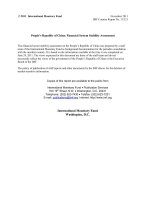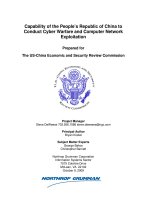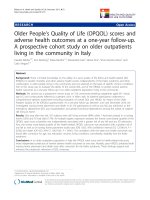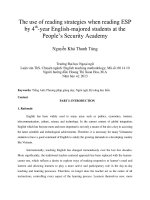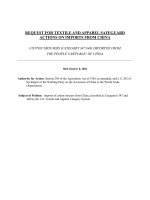The people’s republic of amnesia tiananmen revisited
Bạn đang xem bản rút gọn của tài liệu. Xem và tải ngay bản đầy đủ của tài liệu tại đây (22.56 MB, 281 trang )
Tai Lieu Chat Luong
THE PEOPLE’S REPUBLIC OF AMNESIA
THE
PEOPLE ’S
R EPUBLIC OF
AM NESI A
Tiananmen Revisited
LOUISA LIM
1
1
Oxford University Press is a department of the University of Oxford.
It furthers the University’s objective of excellence in research, scholarship,
and education by publishing worldwide. Oxford is a registered trademark of
Oxford University Press in the UK and certain other countries.
Published in the United States of America by
Oxford University Press
198 Madison Avenue, New York, NY 10016, United States of America
© Louisa Lim 2014
All rights reserved. No part of this publication may be reproduced, stored in
a retrieval system, or transmitted, in any form or by any means, without the prior
permission in writing of Oxford University Press, or as expressly permitted by law,
by license, or under terms agreed with the appropriate reproduction rights organization.
Inquiries concerning reproduction outside the scope of the above should be sent to the
Rights Department, Oxford University Press, at the address above.
You must not circulate this work in any other form
and you must impose this same condition on any acquirer.
Library of Congress Cataloging-in-Publication Data
Lim, Louisa.
The People’s Republic of amnesia : Tiananmen revisited / Louisa Lim.
pages cm
ISBN 978–0–19–934770–4 (hardback) 1. China—History—Tiananmen Square
Incident, 1989. 2. China—History—Tiananmen Square Incident,
1989—Influence. I. Title.
DS779.32.L55 2014
951.05′8—dc23
2013044312
1 3 5 7 9 8 6 4 2
Printed in the United States of America
on acid-free paper
To those who dare speak out
CONTENTS
Author’s Note ix
Timeline xii
Maps xiv
Introduction 1
1. Soldier 7
2. Staying 31
3. Exile 60
4. Student 83
5. Mother 105
6. Patriot 133
7. Official 157
8. Chengdu 182
Afterword: “The Debt of Memory” 206
Acknowledgments 213
Notes 215
Bibliography 231
Index 237
AUTHOR’S NOTE
To write about present-day China requires an almost impossible
calculation, weighing the risks and consequences of every sentence.
It is like juggling in the dark, given the void of information into
which these words fall. The very need for these acts of reckoning
is also the reason why this book is necessary. As the boundaries of
what is considered politically acceptable in China narrow, the subtle
algebra of self-censorship has steadily diminished free expression
both within China’s borders and beyond. This process has quickened in recent years, as the Chinese government has expelled some
foreign journalists and denied visas to others. Because my family
has made China its home for the past decade, I could not help but
contemplate these issues as I decided whether to write this book.
But one question kept nagging: if I—with all the freedoms available to me—chose not to write about June 4th, then would anyone
else document these stories for the historical record? Historical fact
should not be held hostage, and the line between compliance and
collusion is vanishingly thin.
I owe an enormous debt to those who have shared their stories
with me, especially as most do not have the option of being able to
publish their own accounts or to leave China. All were aware that
they were taking a risk in talking about the sensitive topic of June 4th
to a Western journalist. As I wrote these chapters, I wrestled with
the question of whether to strip out their details to try to protect
them, and for a very small number of my interviewees, I did indeed
take that step. But most of those who spoke to me are so well known,
x
Au t h o r’s N o t e
and their experiences so unique, that their identities cannot be disguised. These people gave me permission to use their real names,
and I know these decisions were not taken lightly. I hope that this
book will honor the trust they have placed in me to tell their stories.
None of the people with whom I spoke inside China knew that
I would write about the brutal crackdown in the city of Chengdu
in June 1989. I only began to discover what had happened there
during a chance meeting with Tang Deying, whose teenage son was
beaten to death in police custody in June 1989. I did not begin further research on Chengdu until after I had left China. In writing this
book, I hope to begin a conversation about the “other Tiananmens”
that took place beyond the capital, to remember the victims of the
crackdown, and to break the code of silence in China that surrounds
discussion of 1989.
January 2014
TIMELINE
A P R I L – J U N E 1 9 8 9
April 15
Death of deposed CCP General Secretary Hu Yaobang.
April 16
Students mobilize on some Beijing campuses.
April 17
First student march to Tiananmen.
April 18–19 Student sit-in at Xinhuamen ends in scuffles with
police.
April 21
100,000 students gather on Tiananmen Square.
April 22
Hu Yaobang’s memorial service is held inside Great
Hall of the People; three students kneel on steps
outside.
April 24
Beijing Autonomous Federation of Students formed.
Class boycott begins.
April 26
People’s Daily editorial labels the student movement
“turmoil.”
April 27
Massive demonstations against April 26th editorial.
May 4
CCP General Secretary Zhao Ziyang pledges no
“major” turmoil during a speech to the Asian
Development Bank.
May 13
Student hunger strike begins in Beijing.
Timeline
xiii
May 14
Elected student representatives meet officials, but
talks break down.
May 15
USSR President Mikhail Gorbachev begins state visit
to Beijing.
May 17
More than a million people march in Beijing.
May 18
Premier Li Peng meets student leaders at the Great
Hall of the People.
May 19
Zhao Ziyang visits students on the square during his
last public appearance. Students end their hunger
strike. Troops attempt to enter Beijing ahead of martial law, but citizens block their advance.
May 20
Martial law is officially declared at 10 a.m.
May 23
Troops pull back to the outskirts of Beijing.
May 27
Students vote unanimously to retreat at the end of
May, but decision is immediately overturned.
May 28
Zhao Ziyang’s secretary Bao Tong is arrested.
May 29
Thirty-foot-high Goddess of Democracy statue
unveiled.
June 3
Four intellectuals begin hunger strike.
June 3–4
Thousands of troops deployed into central Beijing.
Troops open fire on civilians; tanks roll into
Tiananmen Square. Preliminary Chinese reports say
241 people died; eyewitnesses believe the figure is
higher.
June 4
Protests against the violent suppression break out in
dozens of cities across China, including Chengdu.
June 5
Foreign media film a young Chinese man standing
in the path of a column of tanks; he becomes known
as Tank Man.
June 9
Central Military Commission Chairman Deng
Xiaoping makes his first appearance since the
crackdown, saying the government has suppressed a
counterrevolutionary rebellion.
A victim of police brutality clutches his injured head as he waits to receive medical
treatment in Chengdu on June 4, 1989. According to official statistics, 8 people were
killed and 1,800 injured in Chengdu in clashes with police. This little-known episode
has not been written about before now, and these pictures taken by Kim Nygaard have
never before been published.
Angry protesters face off against riot police in Chengdu’s Tianfu square on June 4,
1989. The pictures Kim Nygaard took (on right) at a Chengdu clinic show the prevalence
of head wounds in a vivid illustration of the police strategy of using their batons to
target protesters’ heads.
The protest movement spread far beyond Beijing, but that has been largely forgotten.
These photos from mid-May show citizens thronging the streets of Chengdu bearing
banners with slogans including “Power Belongs to the People.” Students later occupied
Chengdu’s Tianfu Square, staging a hunger strike at the foot of the Chairman Mao statue.
Thousands took to the streets of Chengdu on June 4, 1989 in a brave protest against
the killings in Beijing. The authorities used tear gas and stun grenades to try to
disperse the marchers, but fighting broke out. Police were massively outnumbered and
were forced to withdraw to government buildings, which were attacked by crowds, as in
the middle left picture. Overnight, the city was plunged into chaos, with angry citizens
setting fire to government property.
This photo, known as Tank Man, by AP’s Jeff Widener, is the iconic representation of the
Tiananmen movement in the West. Yet in China, few young people can even identify it,
so deep is the chasm of knowledge surrounding the events of 1989. Out of 100 Beijing
university students, only 15 recognized this shot.
